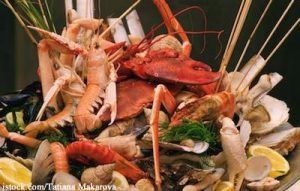The California Department of Public Health is updating its warning to consumers about some seafood caught along the coast. Dungeness and Rock crabs, along with mussels and clams in some counties should not be eaten because they may contain high levels of domoic acid, a toxin. No illnesses have been reported to date in connection with the consumption of these fish.
 Consumers should not eat recreationally and commercially caught Dungeness and Rock crabs caught in the waters between the Oregon border and the southern Santa Barbara County line. The advisory has been extended to recreationally harvested bivalve shellfish (mussels and clams) from Humboldt and Del Norte counties. The white meat (adductor muscle) of scallops caught in those areas can be eaten, but the viscera should be discarded.
Consumers should not eat recreationally and commercially caught Dungeness and Rock crabs caught in the waters between the Oregon border and the southern Santa Barbara County line. The advisory has been extended to recreationally harvested bivalve shellfish (mussels and clams) from Humboldt and Del Norte counties. The white meat (adductor muscle) of scallops caught in those areas can be eaten, but the viscera should be discarded.
An advisory is no longer in place for bivalve shellfish such as mussels and clams or for small finfish such as anchovies and sardines caught in Santa Cruz, Monterey, or Santa Barbara County areas. Testing has revealed that domoic acid has declined and remains at undetectable levels in samples from those species in those areas.
Domoic acid is a toxin that naturally occurs in seafood. It is related to the bloom of a single-celled plant called Pseudo-nitzschia in ocean waters.
The symptoms of domoic acid poisoning can occur within 30 minutes to 24 hours after eating contaminated seafood. Symptoms include vomiting, diarrhea, abdominal cramps, headache, and dizziness and will appear in several days in mild cases. But in severe cases, the patient may have trouble breathing, confusion, disorientation, cardiovascular instability, seizures, excessive bronchial secretions, permanent loss of short term memory (Amnesic Shellfish Poisoning), coma, or death.
Public health officials will continue to sample shellfish and bivalves until the threat has been eliminated. It is not possible to predict where domoic acid will accumulate in shellfish, so officials test these products often.




